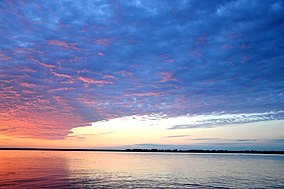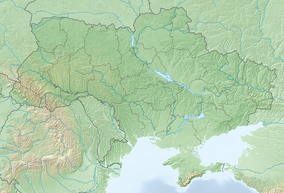|
Shatsk National Natural Park
Shatsk National Natural Park (Ukrainian: Шацький національний природний парк) is a national park of Ukraine which was established in 1983 and aimed to preserve, reconstitute and to use effectively Volyn Polissia natural complexes and objects of special environmental, recreational, educational and aesthetic value. The park is located on the territory of Kovel Raion in northwest part of Volyn Oblast. The general area of the park is 490 square kilometres (190 sq mi), 188 km2 (73 sq mi) of which are handed over for its permanent use. Lesia Ukrainka Volyn State University is a scientific curator. Two ecological paths, Svitiazianka and Lisova Pisnia, are working in the Shatsk NNP. GeneralThe Shatskyi Lakes group is one of the biggest in Europe. On its territory there are more than thirty lakes of varying sizes. Their total area is almost 70 square kilometers. They constitute one of the biggest European groupings of lakes. Among them is Svitiaz, the deepest lake in Ukraine, with an area of 28 square kilometers and a depth of 58 metres (190 ft). The water reserve is 310 million cubic meters; 180.8 million cubic meters of them are kept in Svitiaz.  The majority of lakes are joined to each other by soil-reclamation canals of Soviet or earlier times, or natural channels.[citation needed] As long as the main European watershed goes through Shatsk Region, surplus water from them periodically replenishes basins of the Baltic and the Black seas via the Bug and the Vistula, the Prypiat and the Dnieper rivers accordingly. Forests occupy 52.5% of general park area, grasslands 7.3%, marshes 2.8%, and water reservoirs 14.2%. The rest of the area is taken by farms and roads. According to the Ramsar Water and Moor Protection agreement, the Shats'k lakes' lands which are situated between the Prypiat and the western Bug are considered to be one of the most important areas in Ukraine. In this territory, migrating birds can find places for their reproduction as well as food and rest on their way from the north to warmer countries. The SNNP, together with the local administration, manage the main nature protection tasks. Due to these achievements, the park was included in the World Network of Biosphere Reserves (as West Polesie Transboundary Biosphere Reserve) within the frameworks of the UNESCO "Man and the Biosphere Programme" on April 30, 2002. By this act, the Shats'k lakes were referred to as some of the most precious complexes of the Earth. In Ukraine, Svitiaz Lake is considered to be one of the Seven Natural Wonders of Ukraine. Lakes
Svitiaz LakeSvitiaz Lake is of karst origin; it was formed due to progradation of chalk rocks and subsequent huge cenotes. Nowadays the length of the lake is 9.3 km, its width is 4.8 km, and its surface is more than 27 square kilometers. The lake is fed by either artesian springs or precipitation. Water in Svitiaz is extremely transparent (in sunny weather a submerged white circle is visible to a depth of 8 m), clean and soft. It is determined that it is rich in silver ions and glycerol. Along the lakeside, especially in the area of the tract "Hriada" and hotel "Shatski Lakes", Svitiaz is mostly shallow and on sunny days warms up quickly. On a clean sandy bottom one can go a half or even two hundred meters until the water reaches the chest of an adult man. However, the depth of two meters has an area of 1.2 square kilometers, up to three meters – 7.2, up to five meters – 10.6, to ten meters – 4.2, more than ten – 5.3 square kilometers. Therefore, Svitiaz is mainly a very deep lake. Yet by already mentioned "shallow" "Hriada" there are underwater pits: Vovcha – 20 meters, Ohriadna – 15, Kamin – 14, and Verteneva – 17 meters. The maximum depth of the lake is 58.4, and the average – 7 meters. The lake has an island near the deepest place in Svitiaz – the Holodnetska cavity (58.4 m). One of the legends tells that all the Polissia used to be a sea with whales. When the sea dried out and only the deepest places remained, it became Svitiaz now and its whale became an island. At the beginning of 1970, several European rabbits were settled there for the experiment. In a short time they quickly multiplied and practically destroyed all vegetation. They did not pose a threat only to the highest island trees – giant poplars which had very rough bark. In order to save the island, foresters had to kill them. The island is one of the few places in Ukraine where Bufo calamita toads live. There is also mass bird nesting, many species of which are rare. During nesting, visiting the island is prohibited. In Svitiaz and other lakes of the park, the use of motor boats that may pollute water with fuel or oils is prohibited. Flora and faunaIn the Shatsk Lakes territory, 1180 species of plants belonging to 124 families are found. Among them there are 795 species of higher vascular plants and 112 bryophytes. 332 vertebrate species have been noted in the park: 55 mammals, 241 birds, 7 amphibians, and 29 fish (11 families). Pine and blueberry forests dominate the territory of the park. Alder and birch forests grow in the lowlands. Fauna is represented by typical woodlands species: elk, wild boar, roe deer, rabbits, squirrels. Otter, badger, polecat, marten are rarer. In the waters of the park are about 30 species of fish: Common roach, Common bream, Northern pike, carp, two catfish species (the introduced Channel catfish and the native Wels catfish), European eel and others. Three major faunal types are represented within Shatsk National Park: forest, wetland and synanthropic. In proportion, the first and second types dominate. The composition of the forest complex includes a third of the mammals and more than a half of the entire fauna in the park. Most characteristic representatives of a forestry complex are: MammalsDe Selys Longchamps, Apodemus sylvaticus L., Dryomys nitedula Pall. and Glis glis L., Sciurus vulgaris L., Erinaceus, europeus L, Talpa europaea L., Sorex araneus L., Sorex caecutiens Laxm.S. minutua L., Crocidula suaveolens Palb. and C. leucodon Herman, Vespertilio serotinus Schreb., Mustela putorius L., Martes martes L., Mustela erminea L., Lepus europaeus Pallas, Vulpes vulpes L., Sus scrofa L., Capreolus capreolus L., Alces alces L.; The wet-land complex (lakes’ waters, marshes, wet meadows) contains approximately of one-third of all the Park warm-blooded (about 30 mammals species and 60 birds). The most characteristic representatives are: mammals – mole, common shrew, white-toothed shrew, ermine, vole (Arvicola terrestris L.) and Microtus agrestis L.; BirdsPodiceps cristatus L., Ardea cinerea L., Cygnus olor Gm., Anas platyrhynchos L., A. querquedula L, Aythia fuligula L., Porzana porzana L., P. parva Scop., Rallus H L., Fulica atra L., V. vanellus L., Tringa totanus L., G. gallinago L., Scolopax rusticola L., L. Limosa L., Larus ridibundus L., Sterna hirundo L. and Chlidonias nigra L., Circus aeruginosus L., Motacilla alba L. and M. flava L., Anthus pratensis L., R. riparia L., Lanius excubitor L., Locustella fluviatilis Wolf., Acrocephalus schoenodaenus L., A. palustris Bechst., A. scirpaceus Herrn. and A. arundinaceus L., Emberiza schoeniclus L., P. pica L., hooded crow and others. The synatrophic complex (farmland, settlements) consists of the smallest amount of warm-blooded, only about 20% of the total amount in the Park. The most characteristic representatives are: MammalsMus musculus L. and Apode- mus agrarius Pall., Microtus arval- is Pall., Rattus norvegicus Berktnhout, Erinaceus eiiropaeus L., Talpa europaea L., Plecotus aiiritus L., Muscardinus avellanarius L. and Gris gris L., Lepus europaeus Pall., Mustela nivalis L., Mustela putorius L., Martes foina (Erxleben); Functional zonesIn order to perform its tasks and in accordance with the general plan and the Ukrainian Law "About the Nature Reserve Fund of Ukraine", the park's territory is divided into four functional zones. The zones were pointed out by taking into consideration such factors as a level of the natural complexes preservation, a landscape type, traditional economic activities, a state of flora and fauna objects, cultural and aesthetic values of the objects. The distinguished zones are the following:
On the territory of the SNNP different scientific investigations are conducted to prevent any possible deterioration of the ecological situation in the Shats'k lakes district. The Park's scientific department also works in the frames of the "Nature Chronicle Program for the Sanctuaries and Nature National Parks". Rare plants and animalsThe Green Book of Ukraine includes 14 plant communities among them rare for Ukraine pine forests with undergrowth of juniper communities featuring spruce, located on the southern edge of the range, as well as rare for Polissia leucobryum pine forest, bearberry pinery, thorny ground-pinery, arctic dwarf birch grouping and others. Aldrovanda vesiculosa L. – (3) 33 species of vertebrates: Neomys anomalus Cabrera – (3) VacationIn summer Shatsk’ population (6.3 thousand people) increases threefold. The number of people in the area (in winter 17.3 thousand) increases to 40 thousand and more. See alsoReferences
SourcesWikimedia Commons has media related to Shatsky National Nature Park.
|
||||||||||||||||||||||||||||||||||||||||||||||||||||||||||||||||||||||||||||||||||||||||||||||||||||||||||||||||||||||||||||||||||||||||||||||||||||||||||||||||||||||||||||||||||||||||||||||||||||||||||||||||||||||||||||||||||||||||||||||||||||||||||||||||||||||||||||||



